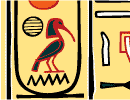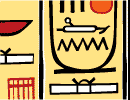Jan. 14, 2000 -- DISCOVERY NEWS BRIEF
Nile River Tombs Exposed
Rossella Lorenzi
The Nile River's west bank may hide a labyrinth of lost tombs, says a team of Japanese experts in the latest issue of "Discovering Archaeology."
Using satellite data, the researchers from Tokai University located 38 points where the remains of the lost pyramids of three Egyptian kings -- Menkauhor, Neferkare and Ity -- could be buried.
It's known that the kings of the Old and Middle Kingdoms, who ruled between 2800 and 1780 B.C., turned the Nile's west bank into a giant funeral area, but the tombs of the three kings have never been found.
"It was impossible to verify all 38 points, because most of them were under military control or within the concession areas of other archaeological teams. Anyway, I think it is possible to find unknown pyramids, though they must be collapsed or unfinished," says Masahiro Etaya of Tokai University.
Detailed images of the Giza plateau were created by scanning with different wavelengths of radar. After high-resolution optical images turned up the outlines of the bedrock, limestone or mud-brick remains, a 3-D simulation helped to locate the "pyramid zones."
During the dynastic period, the Nile valley flooded annually, but the 3-D water level fluctuation model showed that most pyramids and major remains sat 40 meters above the waters.
One point at Dahshur North, less than 20 miles south of Cairo, caught the experts' attention: It showed three circular hollows in a diagonal line, similar to the Great Pyramid formation at Giza.
As work moved from space to Earth, a team of Egyptologists joined the team and finally unearthed a limestone pyramidion -- a mini-pyramid atop a spectacular tomb complex.
In three years of excavations, the archaeologists have uncovered what was probably the major cemetery in late 18th to the early 19th Dynasty. More than 4,000 objects, including some bearing names such as Tutankhamun and Rameses II, have been recovered. The most spectacular finding was the sarcophagus of Mes, a royal scribe who was responsible for training young princes in horseback riding and archery.
But the three kings' tombs remain unfound.
"The discovery is very important because this is the first time that New Kingdom tombs, dating from 1550 B.C., have been found at Dahshur," says Zahi Hawas, Egypt's pyramids director.
Though it is hard to imagine anything like the pyramids at Giza still buried under the sand, he believes that traditional digging has uncovered only 30 percent of his nation's ancient monuments.
"The eyes in the sky promise more discoveries. I think microwave remote sensing data could be a powerful tool in the future," says Etaya.





